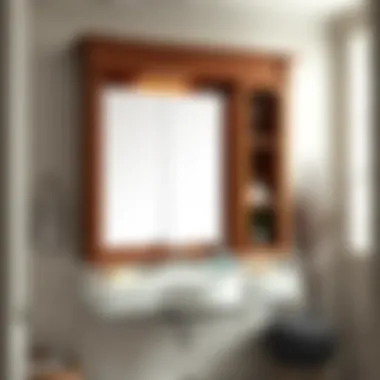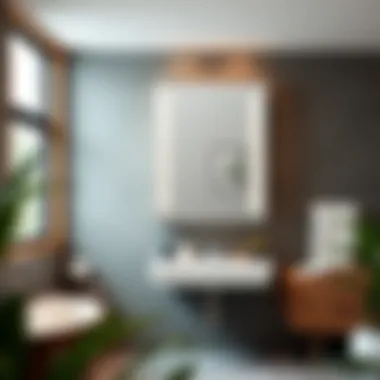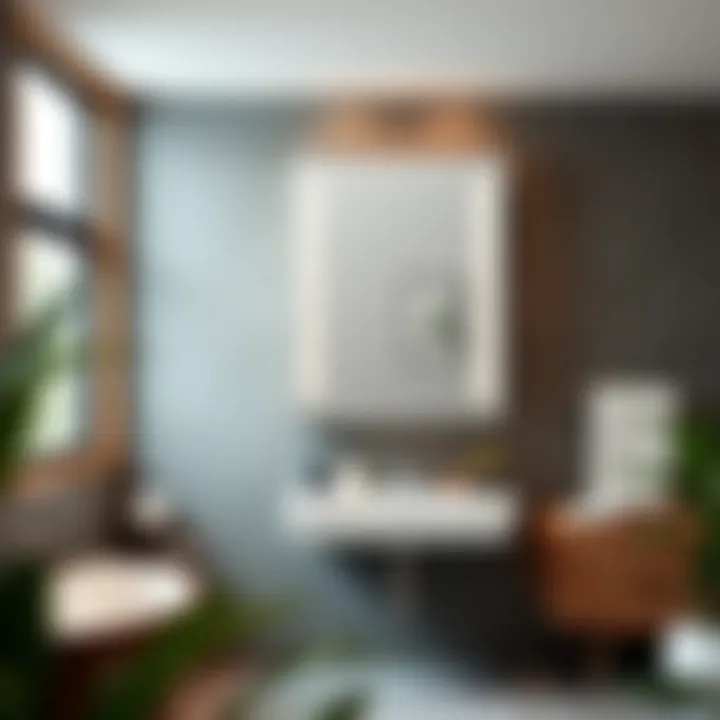Bathroom Built-In Medicine Cabinets: Function Meets Style


Intro
In today’s world, where every square inch of living space matters, bathroom built-in medicine cabinets have emerged as not just a storage solution, but as a central element in the design narrative of modern bathrooms. Beyond their practical use for storing medicine, toiletries, and various personal items, these cabinets add flair and functionality to the space. The conversation around bathroom organization is evolving, with built-ins taking the spotlight, transforming the way we perceive and utilize our bathrooms.
By examining design styles, materials, and innovative installations, it becomes clear how these cabinets can significantly enhance both the look and functionality of a space, catering to homeowners, designers, and DIY enthusiasts alike. From minimalistic aesthetics to elaborate architectural details, built-in medicine cabinets are no longer an afterthought but an intentional choice that brings together utility and design. As we embark on this exploration, it’s essential to recognize the intersection of style and practicality that these installations offer, sharpening the focus on what truly transforms our bathrooms into organized havens.
Furniture Trends
Current Market Trends
The market for built-in medicine cabinets reflects the broader trends in home decor and furniture. Currently, there is a noticeable shift towards sustainable materials. Homeowners are increasingly opting for cabinets made from reclaimed wood or Eco-friendly composites, reflecting a desire for environmentally conscious design.
Another trend is the adaptation of technology. With the rise of smart homes, many cabinets now integrate smart lighting and charging stations. Studies show that up to 57% of homeowners are interested in bathroom tech upgrades, showing a clear linkage between modern living and design solutions.
Moreover, versatility is key. Many designs now allow for customization, which means that cabinets can be tailored to fit unique spaces, accommodating various needs and preferences. For instance, having adjustable shelves, under-cabinet lighting, and mirrors with Bluetooth speakers are features that resonate with today's consumers.
Popular Styles and Designs
When diving into the world of built-in medicine cabinets, a medley of styles vie for attention. Notable trends include:
- Minimalism: Clean lines and understated finishes dominate this design style. White or neutral tones create an airy feel, allowing smaller bathrooms to feel more spacious.
- Industrial: The juxtaposition of rustic materials with modern aesthetics captivates homeowners looking for something unique. Metal frames paired with reclaimed wood evoke a warm vibe.
- Traditional: Ornate moldings and rich wood finishes cater to those who appreciate a classic touch. Such designs can evoke nostalgia while serving a contemporary purpose.
- Modern vintage: This fusion of retro aesthetics with modern functionality has gained traction. Think frameless mirrors alongside vintage-inspired knobs for a charming look.
In the labyrinth of design choices, one can find inspiration everywhere. The popularity of Pinterest boards dedicated to bathroom design amplifies this trend, with thousands of users pinning various styles and configurations every day. Homeowners can lose themselves in an ocean of ideas that cater to both their tastes and practical needs.
"A medical cabinet allows not only storage but speaks volumes of their owner’s style and values."
As this exploration of built-in cabinets unfolds, it becomes imperative to analyze the practical aspects of installation methods and DIY opportunities that can enhance these trends.
DIY Projects
Step-by-Step Guides
For those looking to embark on a DIY project, crafting a built-in cabinet can be strangely rewarding. Here’s a simple guide to getting started:
- Measure the Space: Accurately measure the area where you want to install your cabinet. Consider both the height and width to ensure a perfect fit.
- Choose Your Materials: Select wood or composite that suits your style and budget. If you fancy a modern look, materials like MDF or plywood could work well.
- Construct the Frame: Base your cabinet around the measurements you took earlier. Create a box-like frame with adequate open spaces for shelves.
- Add Shelves: Cut and install shelves, ensuring they're adjustable based on your storage needs.
- Finish the Surface: Sand the surfaces to make them smooth and apply stain or paint for the final touch.
- Install: Secure the cabinet into the wall space, ensuring it’s properly anchored.
This could seem daunting at first, but breaking it down into steps turns what seems like a Herculean task into a manageable afternoon's work.
Budget-Friendly Ideas
Not every homeowner possesses a treasure chest for renovations, but that shouldn’t limit creativity. Below are some budget-friendly ideas for installing a built-in medicine cabinet:
- Repurpose Existing Furniture: An old dresser or shelving unit can be transformed into a medicine cabinet with some adjustments.
- Shop Second-Hand: Flea markets or thrift stores can yield one-of-a-kind pieces that can be restored or refinished for uniqueness.
- DIY Decoration: Instead of high-end finishes, use stencils or decals to add character to an otherwise plain cabinet.
The journey of understanding built-in medicine cabinets encompasses a consideration of various styles, the latest trends, DIY projects, and practical tips. With this foundation laid, we can now delve deeper into how to ensure these cabinets not only serve their purpose but also amplify the overall essence of the spaces they inhabit.
Foreword to Built-In Medicine Cabinets
In the world of bathroom design, built-in medicine cabinets hold a special place, combining utility with a touch of elegance. The significance of these cabinets transcends mere storage; they serve as essential components that enhance both functionality and aesthetics in a bathroom. As we explore this topic, it’s crucial to understand the specific elements, benefits, and considerations surrounding built-in medicine cabinets.
First and foremost, built-in medicine cabinets offer a sleek, streamlined look. Unlike their freestanding counterparts, which often take up valuable floor space, built-in cabinets fit snugly into the wall, making them ideal for any size of bathroom. This integration significantly contributes to the overall flow of a room. Homeowners and designers alike appreciate how this design choice offers a clean and uncluttered appearance while maximizing available square footage.
Moreover, these cabinets effectively organize everyday essentials—from medicines to toiletries—allowing for quick access and reducing clutter on countertops. With thoughtful organization, a built-in medicine cabinet can turn chaos into calm, enhancing the bathroom experience.
Another critical aspect to consider is customization. Built-in cabinets can be designed to suit varied tastes and preferences. Whether one leans towards minimalist aesthetics or more ornate styles, these cabinets can be crafted to seamlessly align with the overall bathroom design. This versatility allows homeowners to express their personal style while ensuring that function does not compromise aesthetics.
Additionally, built-in medicine cabinets tend to add value to a home. Homebuyers increasingly look for functional and stylish features when evaluating properties. A thoughtfully designed built-in cabinet can become a selling point, offering potential buyers both aesthetics and practicality.
In summary, built-in medicine cabinets bring forth a myriad of advantages and considerations that make them a wise choice for any bathroom. They not only help with organization but also enhance the design and resale value of a home. As we move through this exploration, we’ll unpack their evolution, advantages, and design considerations, offering a detailed guide for homeowners, designers, and DIY enthusiasts to navigate the world of built-in medicine cabinets with ease.
"Built-in medicine cabinets: where practicality meets elegance in your sanctuary."
By understanding their place in modern design, we can appreciate how these cabinets contribute to an efficient and aesthetically pleasing environment in our homes.
The Evolution of Medicine Cabinets
The journey of medicine cabinets is a fascinating reflection of changing societal norms and practices regarding personal care and home organization. Over the years, these functional fixtures have not only served practical purposes but have also adapted to style trends, shifting them from purely utilitarian objects to integral design elements within homes. Understanding the evolution of medicine cabinets reveals their significance, shedding light on how they can influence both the functionality and aesthetic appeal of bathrooms today.
Historical Context
In the early days, medicine cabinets were primarily constructed from repurposed materials. Imagine a simple wooden box, perhaps salvaged from an old piece of furniture. These cabinets were less about design and more about the necessity of storing medicines and other personal care items close at hand. As we advanced through the 19th century, the Victorian era introduced ideas of beauty and craftsmanship. The creation of ornate cabinets featured intricate carvings and leaded glass.
- Practical Use: Initially, medicine cabinets were small, sometimes mounted above sinks or even placed in corner nooks, focusing the necessity of accessibility rather than aesthetics.
- Cultural Shifts: As personal hygiene took on a new significance post-Industrial Revolution, so did the medicine cabinet's role evolve into life management. Families began using them not just for medicines, but also to organize various toiletries and beauty supplies.
Fast forward to the mid-20th century, when the concept of the bathroom as a personal sanctuary started to take hold. Medicine cabinets became more integrated with bathroom design, often featuring mirrored fronts and sleek lines that reflected modern sensibilities. They transitioned from simple boxes to valuable storage units, serving a critical role in the organization within the smaller bathrooms of the time.
Modern Interpretations
Today, the evolution of medicine cabinets reflects a merging of functionality and fashion.
- Design Aesthetic: Contemporary medicine cabinets can be found in a plethora of styles, ranging from minimalist designs that emphasize clean lines to luxurious units adorned with high-end finishes and technology. Glass shelves and adjustable compartments are common features aimed at maximizing organization.
- Technological Integration: The rise of smart homes has also influenced modern medicine cabinets. Many now come equipped with integrated lights, heated mirrors, and even Bluetooth speakers, catering to our increasingly tech-savvy lifestyles.
- Sustainability: There is a growing trend focusing on sustainable materials, with many consumers now opting for cabinets constructed from reclaimed or eco-friendly products, thus merging beauty with environmental consciousness.
As we consider the combinations of practicality and design evolving through time, it becomes evident that medicine cabinets are much more than mere storage; they echo the complexity of modern living, allowing for a seamless blend of personal care and home aesthetics.
Overall, the development of medicine cabinets illustrates a continual adaptation to our changing needs, proving their lasting importance in bathroom design.
By examining the historical context and modern interpretations, we can appreciate the significance of medicine cabinets. Not only do they serve functional purposes today, but they are also pivotal in the personal narrative of home organization and style.
Functional Advantages of Built-In Cabinets


Built-in medicine cabinets bring a variety of functional benefits that enhance both the usability and the aesthetics of a bathroom. They are not just storage units; they are integral to the design and functionality of a space. In this section, we will discuss two crucial aspects: Space Efficiency and Enhanced Organization, which provide a clearer understanding of the innumerable advantages built-in cabinets have to offer.
Space Efficiency
Space is often at a premium in bathrooms, where every square inch can make a significant difference. Built-in cabinets can transform even the smallest restroom into a more functional area. Instead of using up floor space, these cabinets are installed directly into the wall, which helps to free up valuable room. This can be particularly useful in compact urban apartments where optimization is key.
The recess of a built-in cabinet gives a clean, streamlined look, as it integrates seamlessly into the wall. This feature can actually make a small bathroom feel larger and more open. Here’s a few benefits that come with this efficient use of space:
- No Clutter on Counters: With built-in cabinets, all essential items have a designated spot, keeping countertops clear and tidy.
- Maximized Vertical Space: Vertical space can often be overlooked. Built-in cabinets can be designed to extend upwards, using height to store less frequently used items.
- Additional Shelf Space: These cabinets can cram in extra shelves or compartments, making it easier to utilize every inch effectively.
In essence, by substituting conventional floor-standing units with built-in alternatives, you save space without sacrificing style.
Enhanced Organization
Another significant advantage of built-in medicine cabinets is their ability to enhance organization in the bathroom. When we think about the daily hustle and bustle, it’s easy for the medicine cabinet to become cluttered with assorted items—band-aids, toothpaste, and unidentifiable ointments all piled together. Conversely, built-in cabinets encourage better organization and easier access to items.
Some of the aspects that contribute to enhanced organization include:
- Customized Storage Solutions: Built-in cabinets can be designed with specific compartments to suit individual needs. For instance, if you have numerous cosmetics, you might opt for trays or bins within the cabient to categorize items.
- Easily Accessible Items: Rather than rummaging through a drawer, built-in cabinets allow clearly visible shelving. You can easily spot what you need, saving time during your morning routine.
- Incorporation of Smart Features: Modern built-in cabinets can include soft-close doors and even lighting that makes finding items easier when the lights are dim.
Enhanced organization not only contributes to a tidy space but can also simplify daily routines, making them more efficient and less chaotic.
With built-in medicine cabinets, one isn't just investing in a stylish piece of furniture; they're investing in functionality that can drastically improve the overall experience of using the bathroom. By embracing the advantages of space efficiency and organization, homeowners can create a more pleasant and manageable atmosphere.
Design Considerations
The design choices made when selecting built-in medicine cabinets can significantly influence not just the aesthetic appeal of a bathroom, but also its functionality. A well-designed cabinet can optimize space, enhance organization, and contribute to an overall harmonious design theme. It’s essential for homeowners and designers alike to think carefully about both the practical and the visual aspects of these cabinets during planning and installation.
Styles and Aesthetics
Contemporary Design
Contemporary design is marked by its clean lines, minimalistic approach, and a sense of spaciousness. The key characteristic of contemporary cabinets is that they often feature sleek finishes and simple, unobtrusive hardware. This choice is not only visually appealing but also serves practical needs by providing ample storage without overwhelming the space. A unique feature of contemporary design is the integration of innovative technology, such as built-in lighting or electronic sensors, which can make for convenient use.
Advantages:
- Simplicity: Easy to match with various bathroom styles.
- Space-saving: Designed to cater to modern compact spaces.
However, one disadvantage could be that too minimalistic a design might lack warmth and character, which some may find uninviting.
Traditional Elements
Traditional elements in medicine cabinets evoke a sense of nostalgia and comfort, often characterized by ornate moldings or classic hardware. These cabinets may include features such as framed mirrors or decorative finishes that enhance their charm. A major benefit of traditional design is its ability to seamlessly blend with vintage or rustic bathroom styles, giving character and inviting warmth.
Unique Feature:
- Detailed craftsmanship: Often showcases skilled woodworking, enhancing durability and design appeal.
However, a drawback is that traditional cabinets may not be the best fit for modern bathrooms that prioritize sleek, streamlined looks.
Rustic Options
Rustic options emphasize natural materials and a roughhewn aesthetic, often utilizing reclaimed wood or distressed finishes to exude authenticity. This type of cabinet adds a touch of nature into the bathroom, providing a calming environment. The key aspect of rustic design is that it often tells a story, reflecting a connection to rustic or countryside living.
Advantages:
- Warmth and texture: Creates a cozy atmosphere through natural materials.
- Eco-friendly: Often utilizes sustainable resources which appeal to environmentally conscious consumers.
Nevertheless, rustic designs can sometimes look out of place in more modern bathrooms, potentially leading to a mismatch in overall aesthetics.
Materials Selection
Wooden Finishes
Wooden finishes provide a timeless beauty that adds warmth and richness to a bathroom's decor. The key benefit of wooden cabinets is their ability to meld well with both modern and traditional design elements. Varieties like oak or walnut offer not just durability but also unique grain patterns that make each piece distinct.
Unique Feature:
- Versatility: Can be stained or painted to fit a range of color schemes.
While wooden finishes are aesthetically pleasing, they can be less practical in humid environments unless specially treated for moisture resistance.
Metallic Features
Metallic features can bring a modern edge and sophisticated look to medicine cabinets. The key characteristic of metallic cabinets is their shiny surfaces and reflective qualities, which can help create an illusion of space in smaller bathrooms. This modern style often utilizes materials like stainless steel or anodized aluminum.
Unique Feature:
- Durability: Resistant to corrosion and easy to maintain, offering longevity in a bathroom setting.
However, a downside to these metallic features could be that they may easily show fingerprints, necessitating more frequent cleaning.
Glass Applications
Glass applications in medicine cabinets can create a light and airy feel, making a small bathroom feel larger. The transparency of glass allows for a view into the contents of the cabinet while protecting items from dust and moisture. Frosted or tinted glass adds a layer of privacy, enabling a sleek look while concealing the items within.
Key Characteristic:
- Modern appeal: Offers a sleek, contemporary appearance that can brighten spaces.


Nonetheless, glass materials may pose challenges regarding fragility; they require careful handling and may not suit all households, especially those with young children.
The careful selection of style and material is paramount when considering built-in medicine cabinets, as these choices echo throughout the design and functionality of the entire bathroom. Understanding the balance between aesthetics and practical needs can lead to more satisfying outcomes.
Installation Processes
Installing built-in medicine cabinets is more than just a matter of finding the right spot on a wall to hang them. It's a multi-faceted process requiring careful thought and planning. Understanding the installation process not only ensures a tidy finish but also impacts the functionality of the cabinet in your living space. Make no mistake, when you take the time to get it right from the get-go, you stand to benefit in both the short and long term.
Planning the Space
Planning is key to optimizing your medicine cabinet installation. It's essential to consider the existing architecture and plumbing in the bathroom, as uneven surfaces or behind-the-wall pipes could pose unexpected challenges.
Measuring and Assessing Requirements
To kick things off, you need to dive into measuring and assessing requirements. This step plays a pivotal role because precise measurements can make or break your installation.
- A key characteristic of this aspect is ensuring that the dimensions of the cabinet fit snugly into the allocated space without cramping up your entire bathroom layout. A cabinet that's too large can become an eyesore, while one that's too small might not serve its intended purpose.
- This step is popular among both DIY enthusiasts and professionals, chalking up its success due to its precision-driven nature. You're not just guessing; you’re making informed decisions based on clear data, which is a real ace in your hand.
- One unique feature of this process is that it involves not just vertical measurements but also the depth of the walls. It’s surprisingly easy to underestimate how far back your cabinet can go, particularly where plumbing or wiring are involved, which can lead to costly adjustments later on.
Choosing the Right Location
Once you’ve measured, the next step is choosing the right location for your medicine cabinet. This is no walk in the park, as it requires balancing aesthetic desires with practical needs.
- A significant advantage of a well-chosen location is how it can drastically improve accessibility for family members and guests. Think about where you most often reach for your medicines or toiletries. Easy access can save a lot of hassle on your busy mornings.
- This choice can be quite beneficial as improper placement can make the cabinet feel more like a burden than a help. You wouldn’t want to install it at a height that requires a circus act to reach the top shelf.
- The unique feature of this aspect is its interplay with surrounding fixtures. Avoiding placement too close to a light switch or mirror can prevent functionalities from clashing. However, the challenge is that sometimes you may not have a plethora of options available, especially in small bathrooms.
Professional vs. DIY Installation
When it comes to installation, you often find yourself at a crossroads: hire a professional or take on the challenge of doing it yourself.
Professional Installation
Enlisting professionals can save you time and headaches, particularly if your walls are not uniform or you are unsure about the plumbing layout. A trained hand can work efficiently and minimize errors.
DIY Installation
On the flip side, tackling it yourself can give you a sense of accomplishment. Many find that engaging in DIY projects fosters creativity and uniquely personalizes their space. Be heedful, though, as improper installations can mean backtracking later, which no one enjoys.
Ultimately, knowing whether to go pro or DIY hinges on both your skill level and comfort with tools. For the uninitiated, a pro might be the safer route. At the end of the day, the choice is yours — just make sure it aligns with your vision for your bathroom.
Maximizing Efficiency in Small Bathrooms
In today’s world, where space is often at a premium, particularly in urban areas, maximizing efficiency in small bathrooms has never been more critical. Built-in medicine cabinets offer a practical solution that combines utility and style. By integrating these cabinets into bathroom designs, homeowners can effectively utilize limited space while keeping essential items organized and accessible. This section explores how innovative storage solutions and dual-purpose furniture can significantly enhance the functionality of small bathrooms.
Innovative Storage Solutions
Small bathrooms often come with the challenge of fitting necessary items without sacrificing style. Built-in medicine cabinets emerge as a favorable solution, cleverly utilizing wall space for storage without taking up floor area. Here are a few innovative storage concepts to consider:
- Vertical Space Usage: Make the most of wall height by installing narrow but tall medicine cabinets. This approach can house everything from toiletries to first-aid supplies, reducing clutter on counters.
- Hidden Compartments: Some cabinets come with cleverly designed pull-out shelves or sliding systems. This allows for easy access to items stored deep within and ensures that everything stays neatly tucked away when not in use.
- Mirror Integration: A common trend is to select cabinets that also serve as mirrors. This combination not only saves wall space but also provides the added benefit of making the bathroom appear larger and brighter.
"In a small bathroom, every square inch counts. Built-in medicine cabinets can turn wasted wall space into a smart solution for storage and style."
Employing these innovative storage solutions allows homeowners to maintain a tidy and efficient space, fostering a sense of calm in a room that can often feel cramped.
Dual-Purpose Furniture
When it comes to small bathrooms, dual-purpose furniture can be a game changer. This approach leverages multifunctionality to optimize every piece of decor or fixture within the space. Here are some examples:
- Vanity with Built-In Storage: Some vanities come with integrated shelves or cabinets, providing additional storage for hygiene products, towels, or even cleaning supplies. Utilizing the vanity for storage can keep everything organized and easily reachable.
- Foldable Solutions: Consider foldable or extendable shelves that can be closed or opened as needed. This flexibility allows homeowners to adapt the space for various tasks, such as getting ready in the morning or relaxing in a bath.
- Storage Ottomans: Though often overlooked, incorporating storage ottomans can provide both seating and extra space to store towels or toiletries, adding both comfort and utility.
User Preferences and Trends
Understanding user preferences and current trends is vital when it comes to built-in medicine cabinets. These elements not only influence design choices but also shape the functionality of these cabinets, ensuring they meet the diverse needs of homeowners and tenants today. Additionally, by analyzing preferences, designers can create solutions that resonate with their target audience, paving the way for more personalized and effective designs.
Consumer Insights
Consumer insights reveal a burgeoning inclination towards functionality paired with aesthetics. People are leaning toward designs that enhance usability while providing an attractive finish. Here are some key insights into what consumers are looking for:
- Multi-functionality: Many buyers favor cabinets that serve dual purposes, such as mirror-cabinets providing a space for toiletries while also offering a reflection.
- Customization: Users increasingly appreciate the ability to choose features according to their preferences, like adjustable shelves or integrated lighting setups. This trend allows individuals to create unique storage solutions tailored to their specific needs.
- Sustainability: A growing number of consumers is aware of their environmental footprint, leading them to seek cabinets made from eco-friendly materials such as reclaimed wood or recycled metal.
Investing in consumer insights means that companies can better align their products with what buyers truly desire, resulting in better satisfaction and a lasting impact on the market.
Emerging Trends in Bathroom Design
Several trends are reshaping the landscape of bathroom design, particularly in the realm of built-in medicine cabinets. Staying attuned to these shifts can guide homeowners and designers alike in their choices:
- Minimalistic Design: There’s a strong shift towards minimalism, with sleek lines and uncluttered surfaces gaining popularity. Built-in cabinets are often designed flush with the wall to create a seamless look, which adds to the feeling of spaciousness in small bathrooms.
- Smart Technologies: With the advent of technology, smart medicine cabinets with integrated lighting, Bluetooth speakers, or even touchless sensors are making their entrance in modern bathrooms. These features cater to the demand for convenience and innovation.
- Color and Texture: Bold colors and diverse textures are making waves in medicine cabinet designs. Instead of the conventional white or wood tones, more homeowners are experimenting with vibrant finishes or mixed materials to give their space a unique flair.
As the trends evolve, adapting to user preferences will keep designs relevant and appealing. In this ever-changing landscape, it is crucial for designers and consumers to be aware of these shifts in order to create practical yet stylish solutions that cater to contemporary lifestyles.
"The best designs are those that blend utility with creativity, satisfying both functional needs and aesthetic desires."
By monitoring these preferences and trends, we can anticipate what lies ahead in the design of built-in medicine cabinets, ensuring that they continue to be not just storage spaces, but integral parts of modern bathroom design.
Maintenance and Care
Maintaining a built-in medicine cabinet is more than just a chore; it’s an essential practice for ensuring long-lasting functionality and aesthetics. Regular care helps in preserving the materials used, maintaining hygiene, and ensuring that everything you store inside stays in good condition. Here, we’ll discuss why taking the time to properly maintain your medicine cabinet is vital.
Firstly, a well-maintained cabinet enhances your bathroom's overall look. Grime and clutter can turn a beautiful design into an eyesore. Plus, regular cleaning can help you spot any wear or damage early, saving you from pricey repairs later. If you've put money into a custom built-in cabinet, you'll want to protect that investment. Moreover, how you care for it can impact your health. Cabinets in bathrooms often store medications, first aid supplies, and personal care items. Keeping these areas clean means preventing any mold or bacteria buildup.
Cleaning Best Practices


When it comes to keeping your medicine cabinet spick and span, certain tried-and-true cleaning practices stand out. Here’s a handy guide to get you started:
- Dust Regularly: Make it a point to dust the exterior at least once a week. This simple act can prevent dirt from accumulating and maintaining the gleam of your cabinet.
- Wipe Down Shelves: Use a damp cloth to wipe down the shelves inside. A mixture of warm water and mild soap typically does the trick. If substances have spilled, a little baking soda paste can help lift tough stains.
- Organize and Dispose: Every few months, take a good look at what you’ve got stored. Discard any expired medications or items you no longer need. Rather than just pitching them, look up your local disposal guidelines to ensure you're throwing them out responsibly, perhaps checking resources like Food and Drug Administration (FDA) for safe disposal methods.
- Check for Moisture: Bathrooms can be humid environments. Periodically check your cabinet for signs of mold or mildew, especially if you notice a musty smell when you open it. You may want to invest in silica gel packets or a dehumidifier to keep moisture levels down.
Long-term Care and Durability
Looking beyond routine cleaning, long-term care is critical for the durability of a built-in medicine cabinet. A few points to consider are:
- Material Awareness: Different materials have different care requirements. For instance, wooden cabinets might need oil or varnish to prevent cracking, while metal may require polishing to remove rust spots. Knowing the material you have can help determine the right maintenance regime.
- Regular Inspection: Just like you’d check your roof after a storm, regularly inspecting your cabinetry ensures that you catch any issues such as warping, mold, or loose hinges before they snowball into larger problems.
- Proper Use: How you use your cabinet can affect its longevity too. Avoid overloading shelves with heavy products, which can cause sagging or even breakage. Instead, distribute weight evenly and use storage bins to keep smaller items organized.
- Professional Help: If you notice problem areas that you can’t handle on your own—be it a broken door or worn-out shelving—consider seeking help from a professional. Keeping your cabinet in top shape is vital for longevity.
"A well-cared-for medicine cabinet is like a well-tended garden; it flourishes with the right attention."
In summary, proper maintenance and care of built-in medicine cabinets lead to not only healthier living but also extend the life of your furnishings. It's an investment in both aesthetics and functionality that pays off over time. Regular cleaning, strategic organization, and an awareness of materials can benefit your cabinet significantly, ensuring it remains a stylish and useful part of your bathroom for years to come.
Sustainability in Design
In today's world, the approach to design, especially in home interiors, is increasingly tilted towards sustainability. It’s not just a trend; it’s an essential concept that every homeowner and designer should consider. Built-in medicine cabinets are not exempt from this conversation. As modern living spaces get smaller, effective use of materials and resources has become paramount. Here, we dive into the significance of sustainable design in bathroom medicine cabinets, looking at eco-friendly materials and ethical sourcing.
Eco-Friendly Materials
When we refer to eco-friendly materials, we’re talking about options that have minimal negative impact on the environment. This can span a wide range of materials suitable for built-in medicine cabinets.
- Reclaimed Wood: One option is reclaimed wood, which repurposes timber from old buildings, furniture, or pallets. Not only does this give the wood a story and character, but it also prevents new trees from being cut down.
- Bamboo: Known for its rapid growth, bamboo is another excellent material. It’s a grass rather than a tree, making it more sustainable as it can be harvested without killing the plant.
- Low-VOC Paints and Finishes: For those looking to add color or protect their cabinets, water-based, low-VOC paints and finishes are available. They offer a safer alternative that minimizes the release of harmful chemicals into the home environment.
- Recycled Glass: Using recycled glass for cabinet doors not only adds a touch of elegance but also significantly curtails the energy consumption associated with producing new glass.
The use of these materials promotes a healthier living space, contributing to better indoor air quality and a lower carbon footprint.
Ethical Sourcing of Components
Sourcing materials ethically means ensuring that the components used in construction are obtained in a responsible manner. This applies to everything from the wood for the cabinets to the hardware used in installation.
- Certifications: Check for FSC (Forest Stewardship Council) certification or equivalent. This demonstrates that the wood comes from sustainably managed forests and is harvested with respect for the environment and local communities.
- Local Sourcing: By choosing local suppliers and artisans, the transportation emissions can be reduced, making your cabinets more sustainable. It supports the local economy and reduces the carbon footprint related to logistics.
- Fair Trade Practices: Ensuring that craftsmen and laborers are paid fairly and work in safe conditions is essential. Ethical sourcing extends beyond material; it encompasses a complete consideration of the lifecycle of the cabinet.
"Choose to be conscious; the choices you make today can lead to a greener tomorrow."
As more homeowners prioritize these values, it encourages manufacturers to adapt, driving innovation and setting a standard that may reshape the blueprint for future developments in bathroom design.
Case Studies: Successful Installations
Exploring successful installations of built-in medicine cabinets offers valuable insights into practical applications and enhances our understanding of both functionality and aesthetic appeal. The real-world examples illustrate how these cabinets cater to varying spaces, tastes, and needs. Beyond mere theory, these case studies help homeowners, renters, and designers better grasp the potential impact of built-in medicine cabinets on both organization and style.
Successful installations not only showcase design capabilities but they also demonstrate strategic planning considerations. A well-implemented medicine cabinet can meld seamlessly into a room, maximizing usability while contributing to the overall charm of a bathroom. It’s crucial to recognize the significance of aligning style with function, ensuring that every choice advises both beauty and practicality.
Residential Examples
In residential settings, built-in medicine cabinets serve as more than just storage solutions. They hold the potential to transform ordinary bathrooms into highly functional spaces. For instance, consider a modern home in San Francisco where homeowners needed to utilize every inch. By opting for a built-in cabinet that mirrored the colors of wall tiles, they created a unified look that looks neat and elegant.
Some benefits of residential installations include:
- Space-saving: Built-in cabinets eliminate the need for freestanding units, giving the illusion of a larger area.
- Customization: Homeowners can choose the cabinetry style, finish, and layout tailored to their requirements.
- Increased Value: Effective organization and stylish features can enhance property appeal during resale.
This San Francisco example successfully integrated the vanity and medicine cabinet into a cohesive design that pops! It was particularly effective to store not just medications but also toiletries and grooming essentials.
Commercial Applications
On the commercial side, built-in medicine cabinets can mean the difference between a cramped facility and one that offers a pleasant experience. Imagine a dental clinic that opted for stylish, minimalist medicine cabinets integrated directly into the cabinetry of the reception area. This establishes a professional yet inviting environment.
Key points to consider for commercial installations include:
- Durability: Using robust materials prevents wear and tear in high-traffic areas.
- Accessibility: Designing cabinets for easy access is crucial in healthcare settings or salons where speed matters.
- Regulatory Compliance: Ensure storage meets health standards, which is especially relevant in medical spaces.
One dental practice in Miami reported improvements in patient experience due to the well-designed storage—moving away from clutter and making the visit feel more organized and welcoming.
"Built-in medicine cabinets do more than hold your essentials; they set the tone for how your space functions and feels."
Collectively, these residential and commercial examples underscore the versatility of built-in medicine cabinets. They reveal how thoughtful design can make a considerable difference to both the utility and ambiance of a space.
Through these case studies, a clear message emerges: built-in medicine cabinets are not merely storage solutions. They are integral components of bathroom design that boast elegance and efficiency, enhancing comfort and satisfaction in everyday life.
Final Thoughts on Built-In Medicine Cabinets
As we wrap up this exploration into the realm of built-in medicine cabinets, it becomes clear that these elements are much more than mere storage solutions. They represent a confluence of practicality and aesthetics, crucial for enhancing the functionality of bathroom spaces while also marrying them to design schemes. Built-in medicine cabinets significantly influence how we organize our toiletries and health essentials, serving the dual purpose of maximizing space and adding visual appeal to often cramped quarters.
Impact on Space and Functionality
The advent of built-in medicine cabinets brings about a transformation in how space is utilized in bathrooms. By being recessed into walls, they cleverly free up room for more vital amenities and accessories, which is crucial in smaller bathrooms or spaces where every square foot counts. Typically, a traditional vanity with an overhanging mirror offers limited storage and can overload a room with bulky furniture. In comparison, built-ins seamlessly blend, providing a streamlined look while ensuring everything remains neatly tucked away.
When installed thoughtfully, these cabinets can even make a small bathroom appear larger. They can be fitted with mirrors that enhance light, producing an illusion of depth. When considering placement, it’s advisable to think about accessibility—higher cabinets can store lesser-used items, while essentials might be better placed at easy reach. Ultimately, it's about balancing visibility with aesthetics.
Here’s a quick list of some benefits of built-in cabinets:
- Optimized Space Usage: Free up surface areas by integrating storage into the walls.
- Customizable Designs: Tailor colors and finishes to match your interior style, elevating overall decor.
- Reduced Clutter: Keep bathroom counters clear, enhancing cleanliness and ease of maintenance.
- Durability: Often, built-ins are crafted from high-quality materials, leading to longer-lasting fixtures that withstand moisture and wear.
"Built-in medicine cabinets are more than functional; they're a design statement and a space-saving marvel."
Future Directions in Design
The landscape of bathroom design is ever-changing, influenced by trends in sustainability, technology, and consumer preferences. The future of built-in medicine cabinets seems poised to blur the lines further between storage and style. As the movement toward eco-friendly practices continues to gain momentum, manufacturers are likely to focus on sourcing sustainable materials and incorporating energy-efficient lighting solutions within cabinet designs.
Moreover, the integration of smart technology in bathroom spaces shapes another central theme for future designs. Imagine cabinets equipped with motion-sensing lights or even Bluetooth speakers embedded into their structure. These features push the envelope of what functionality can entail, inviting homeowners to merge convenience with cutting-edge design.
A few anticipated trends in the future include:
- Smart Storage Solutions: Built-in cabinets featuring integrated tech for better organization and accessibility.
- Innovative Materials: Biodegradable materials and sustainable woods that also offer durability in humid environments.
- Personalized Sizes: More customizable options that adapt to the unique dimensions of modern bathrooms, rather than a one-size-fits-all approach.
As we look ahead, it's clear that built-in medicine cabinets will only grow in importance, harmonizing design, technology, and practicality in the bathrooms of tomorrow.















